 |
 03-16-2011, 09:41 PM
03-16-2011, 09:41 PM
|
#1
|
Join Date: Aug 2009
Posts: 195
|
Need Help ASAP
Hello its been a while hasn't it?
Well i got an 87 IROC Z last year and i unfortunately let it sit a little too long, the alternator has died. So i bought a new one and put it on and then charged the batter up. The thing with the battery is that i was using a plug-in battery charger so its not fully charged? I don't know.
THe Problem:
The belt turns over like once but doesn't get the engine turned over do i need to charge the battery up more or is there a problem with the starter or selnoid?
Thanks in advance.
__________________
Brendan D. ONeill
96 Blk Jeep - Totaled
95 Wht Jeep - Sold
95 Z28 Camaro Sold I want to sell the IROC and get the 95 back or something a year or two off
87 IROC-Z28 Camaro
|

|

|
 03-16-2011, 09:43 PM
03-16-2011, 09:43 PM
|
#2
|
Join Date: Nov 2007
Location: Jackson, NJ
Posts: 1,718
|
So did you try jumping it?
__________________
1983 camaro- Scrap
1988 camaro- Also scrap
'05 Silverado- You guessed it, scrap
1988 TRX 250R- Ported w/ high compression on 110 octane- Out 60' your LT1
Jersey Shore Street Car Takeover (JSSCT) Founder
Quote:
Originally Posted by LS1ow

and once i get PHB, what do i ajust it too?
|
Quote:
Originally Posted by Jersey Mike

Seven.
|
|

|

|
 03-16-2011, 09:44 PM
03-16-2011, 09:44 PM
|
#3
|
Join Date: Feb 2009
Location: bridgewater
Posts: 868
|
Let it charge longer or if its manual you could try pop starting it by giving it a good push and dumping the clutch
__________________

Quote:
Originally Posted by BigAls87Z28

its an ongoing joke between the Geo Storm crew and the Sebring coupe team.
|
bolt-ons and a bed n' breakfast
|

|

|
 03-16-2011, 09:50 PM
03-16-2011, 09:50 PM
|
#4
|
Join Date: Aug 2009
Posts: 195
|
ib4200 you've seen my driveway that would be an ingenius idea, but sadly it is auto.
Nope, no one has real jumper cords that i have access to right this moment, talk about a real car guy huh? lol i'll let it charge for like 2-3 hours or so, it was taking a charge but not a strong battery yet i don't think.
__________________
Brendan D. ONeill
96 Blk Jeep - Totaled
95 Wht Jeep - Sold
95 Z28 Camaro Sold I want to sell the IROC and get the 95 back or something a year or two off
87 IROC-Z28 Camaro
|

|

|
 03-16-2011, 09:52 PM
03-16-2011, 09:52 PM
|
#5
|
Join Date: Feb 2009
Location: bridgewater
Posts: 868
|
i'd help you out this weekend but if you let it charge by itself it'll start by then.
__________________

Quote:
Originally Posted by BigAls87Z28

its an ongoing joke between the Geo Storm crew and the Sebring coupe team.
|
bolt-ons and a bed n' breakfast
|

|

|
 03-16-2011, 09:53 PM
03-16-2011, 09:53 PM
|
#6
|
Join Date: Mar 2005
Location: nj
Posts: 248
|
where do you live? maybe someone has some jumpers near you. i always keep em in my trunk and i dfrive an 09 chevy cobalt ss...never know when someone will need a hand.
__________________
2018 vw golf r m6
2005 subaru outback m5
1999 camaro ss heads/cam m6
Previous
1999,, 2001, 2002 Chevy camaro ss, 1998 camaro z28, 2013 camaro 1le twin turbo all m6
|

|

|
 03-16-2011, 09:58 PM
03-16-2011, 09:58 PM
|
#7
|
Join Date: Aug 2009
Posts: 195
|
im right in Bridgewater, i can see the Bridgewater Manor and Indian Temple from my house or im just off rt 202/206
__________________
Brendan D. ONeill
96 Blk Jeep - Totaled
95 Wht Jeep - Sold
95 Z28 Camaro Sold I want to sell the IROC and get the 95 back or something a year or two off
87 IROC-Z28 Camaro
|

|

|
 03-16-2011, 10:03 PM
03-16-2011, 10:03 PM
|
#8
|
Join Date: Mar 2005
Location: nj
Posts: 248
|
Quote:
Originally Posted by Brendan713

im right in Bridgewater, i can see the Bridgewater Manor and Indian Temple from my house or im just off rt 202/206
|
i'm right in middlesex, but its too late for me to go anywhere. if you got a second car you can pick up the jumper cables to borrow if you want.
__________________
2018 vw golf r m6
2005 subaru outback m5
1999 camaro ss heads/cam m6
Previous
1999,, 2001, 2002 Chevy camaro ss, 1998 camaro z28, 2013 camaro 1le twin turbo all m6
|

|

|
 03-16-2011, 10:11 PM
03-16-2011, 10:11 PM
|
#9
|
Join Date: Aug 2009
Posts: 195
|
yeah don't worry about it, thanks anyways, i've got one car.
__________________
Brendan D. ONeill
96 Blk Jeep - Totaled
95 Wht Jeep - Sold
95 Z28 Camaro Sold I want to sell the IROC and get the 95 back or something a year or two off
87 IROC-Z28 Camaro
|

|

|
 03-16-2011, 10:20 PM
03-16-2011, 10:20 PM
|
#10
|
Join Date: Apr 2008
Location: Delran
Posts: 6,785
|
put a volt meter on the battery and check the voltage. if the voltage is fine then crank it while checking the voltage...if its less than 10 volts at startup the starters junk.
|

|

|
 03-16-2011, 10:46 PM
03-16-2011, 10:46 PM
|
#11
|
Join Date: Jul 2004
Location: West Long Branch
Posts: 13,598
|
Wait...wait...
You purchased an Alternator because the car sat for too long? WTF does that mean?
Why did you buy an alternator? Take the battery out, take it to Advance/Auto Zone and have them charge and test the battery for free.
__________________
2/20/2013: They Day the ****s Stopped
|

|

|
 03-16-2011, 10:57 PM
03-16-2011, 10:57 PM
|
#12
|
Join Date: Dec 2005
Location: Mays Landing, NJ
Posts: 7,108
|
Quote:
Originally Posted by BigAls87Z28

Wait...wait...
You purchased an Alternator because the car sat for too long? WTF does that mean?
Why did you buy an alternator? Take the battery out, take it to Advance/Auto Zone and have them charge and test the battery for free.
|
^^ This
__________________
2018 Camaro 2SS Redline package, ESC Novi 1500 tuned by EFX, Might Mouse wild catch can, GM STB, smoked ZL1 3rd brake light, Xpel XR Black 35% tint all around, Street Scene front splitter, C7 Carbon ZL1 side skirts, Drake Muscle Car Wickerbill spoiler
2010 Infiniti G37x-Moonlight White w/Graphite interior. Stock...for now. Xpel XR Black tint(hey it's a mod lol)
|

|

|
 03-16-2011, 10:59 PM
03-16-2011, 10:59 PM
|
#13
|
Join Date: May 2010
Location: Brick, NJ
Posts: 1,868
|
Quote:
Originally Posted by BigAls87Z28

Wait...wait...
You purchased an Alternator because the car sat for too long? WTF does that mean?
Why did you buy an alternator? Take the battery out, take it to Advance/Auto Zone and have them charge and test the battery for free.
|
i agree
__________________
Formerly known as blk95formula
86t/a_ram_air on TGO
2018 Silverado 1500
|

|

|
 03-16-2011, 11:52 PM
03-16-2011, 11:52 PM
|
#14
|
Join Date: Aug 2009
Posts: 195
|
im sorry i wasn't clear enough before, i've known for a long time that the alternator was slowly dying, last time i had it running i had to do it a couple times before it turned over.
__________________
Brendan D. ONeill
96 Blk Jeep - Totaled
95 Wht Jeep - Sold
95 Z28 Camaro Sold I want to sell the IROC and get the 95 back or something a year or two off
87 IROC-Z28 Camaro
|

|

|
 03-16-2011, 11:54 PM
03-16-2011, 11:54 PM
|
#15
|
|
Stalker

Join Date: Aug 2004
Posts: 12,077
|
that doesnt have anything to do with the alternator really
|

|

|
 03-16-2011, 11:58 PM
03-16-2011, 11:58 PM
|
#16
|
|
12 Second Club
Join Date: Aug 2004
Location: Oradell
Posts: 8,368
|
let the battery sit on the charger for a few hours... if not good them take it to be tested like stated above
__________________
86 Camaro
88 Camaro
95 Impala SS
97 Trans Am WS6
98 Blazer ZR2
00 Corvette
04 CTS-V
07 Sublime Charger Daytona
10 Tahoe SSV
12 Tahoe LT
17 Malibu LT
|

|

|
 03-17-2011, 01:35 PM
03-17-2011, 01:35 PM
|
#17
|
Join Date: Oct 2008
Location: Clayton
Posts: 521
|
too me it sounds like the battery itself is bad and wont hold a charge. see if there is a date on the battery, if its more than 3 years old i would just replace it.
|

|

|
 03-20-2011, 04:52 PM
03-20-2011, 04:52 PM
|
#18
|
Join Date: Aug 2009
Posts: 195
|
alright so heres the final scoop on the car situation. The battery can get a charge and hold it long enough to start the car, but once you turn the car off, the battery is dead. The battery needs to be replaced and it will be. The Old alternator was in fact bad, it wasn't holding enough voltage from the battery to turn over and get the car started.
__________________
Brendan D. ONeill
96 Blk Jeep - Totaled
95 Wht Jeep - Sold
95 Z28 Camaro Sold I want to sell the IROC and get the 95 back or something a year or two off
87 IROC-Z28 Camaro
|

|

|
 03-20-2011, 05:32 PM
03-20-2011, 05:32 PM
|
#19
|
|
Co-Founder / Site Admin
Join Date: Jul 2004
Location: Ewing, NJ
Posts: 22,473
|
Quote:
Originally Posted by Brendan713

alright so heres the final scoop on the car situation. The battery can get a charge and hold it long enough to start the car, but once you turn the car off, the battery is dead. The battery needs to be replaced and it will be. The Old alternator was in fact bad, it wasn't holding enough voltage from the battery to turn over and get the car started.
|
Have you had the battery and either the old or new alternator tested? The alternator doesn't have anything to do with starting the car, it doesn't store any power. All the energy used to start the car comes right from the battery.
- Justin
__________________
1999 Camry - Beigemobile DD
2002 Suburban - Wife's DD
2004 Grand Cherokee - Not running / Project / Selling?

|

|

|
 03-20-2011, 07:41 PM
03-20-2011, 07:41 PM
|
#20
|
|
Stalker

Join Date: Aug 2004
Posts: 12,077
|
my gift to you
I believe you are kinda misunderstanding...
and at first i was like....

BUT .... Then i was like....

Take your time and read through the following, im sure all you need to know is here and will give you a much clearer understanding of a cars electrical systems.
TROUBLESHOOTING BASIC STARTING SYSTEM PROBLEMS
Many starting system problems are the result of neglect. This chart will show you which problems you can fix yourself and which require professional service. Problem Is Caused By What To Do Engine does not crank (Solenoid or relay does not click) Dead battery Charge or replace battery Loose, corroded or broken connections Clean or repair connections Corroded battery terminals (lights will usually light) Clean terminals Faulty ignition switch Have ignition switch checked/ replaced Faulty neutral safety switch or clutch switch (To test: push on brake pedal, hold key in start position and move shift lever or clutch pedal) Have neutral safety switch or clutch switch checked or replaced Defective starter switch, relay or solenoid. Have defective component replaced Engine will not crank (Solenoid or relay clicks) Low or "dead" battery Charge or replace battery Corroded battery terminals or cables Clean or replace terminals or cables Defective starter solenoid or relay Have defective component replaced Defective starter motor (if current is passed through relay or solenoid) Have starter replaced or overhauled Starter motor cranks slowly Low battery Charge or replace battery Loose, corroded or broken connections Clean, repair or replace connections Cable size too small Replace with proper size cable Internal starter motor problems Have starter replaced or overhauled Engine oil too heavy Use proper oil viscosity for temperature Ignition timing too far advanced Set timing to specifications Starter spins, but will not crank engine Broken starter drive gear Have drive gear replaced Broken flywheel teeth Have flywheel checked Noisy starter motor Starter mounting loose Tighten mounting bolts Worn starter drive gear or flywheel teeth Have starter or flywheel checked Worn starter bushings Have starter replaced or overhauled
TROUBLESHOOTING BASIC CHARGING SYSTEM PROBLEMS
There are many charging system problems you can fix yourself. This chart will show you which ones you can fix and which ones require professional service. Problem Is Caused By What To Do Noisy Alternator Loose mountings Tighten mounting bolts Loose drive pulley Tighten pulley Worn bearings Have bearings replaced Brush noise Have brushes cleaned /replaced Internal circuits shorted (High pitched whine) Have alternator replaced or overhauled Squeal when starting engine or accelerating Glazed or loose belt Replace or adjust belt Indicator light remains on or ammeter indicates discharge (engine running) Broken fan belt Install belt Broken or disconnected wires Repair or connect wiring Internal alternator problems Have alternator overhauled /replaced Defective voltage regulator Have voltage regulator replaced Car light bulbs continually burn out-battery needs water continually Alternator/ regulator overcharging Have voltage regulator/alternator overhauled or replaced Car lights flare on acceleration Battery low Charge or replace battery Internal alternator/ regulator problems Have alternator/ regulator overhauled or replaced Low voltage output (alternator light flickers continually or ammeter needle wanders) Loose or worn belt Replace or adjust belt Dirty or corroded connections Clean or replace connections Internal alternator/ regulator problems Have alternator or regulator overhauled or replaced
Charging System Basics: The electrical system in an automobile is said to be a 12 volt system, but this is slightly misleading. The charging system in most cars will generally produce a voltage between 13.5 and 14.4 volts while the engine is running. It has to generate more voltage than the battery's rated voltage to overcome the internal resistance of the battery. This may seem strange, but the current needed to recharge the battery would not flow at all if the charging system's output voltage was the same as the battery voltage. A greater difference of potential (voltage) between the battery's voltage and the alternator's output voltage will provide a faster charging rate.
As long as the engine is running, all of the power for the accessories is delivered by the alternator. The battery is actually a load on the charging system. The only time that the battery would supply power with the engine running is when the current capacity of the alternator is exceeded or when engine is at a very low idle.
Alternator Basics
Overview: A basic alternator has 2 main electrical components. The rotor and the stator. The rotor is the part of the alternator that is spun by the drive belt. There are a group of electrical field coils mounted on the rotor. The stator is the group of stationary coils that line the perimeter of the inside of the alternator case. When current (supplied by the voltage regulator - to be explained later) is flowing in the rotor's coils, they induce current flow in the stationary coils. The induced current (and voltage) is an AC current. To convert this to DC, the current is passed through a bridge rectifier.
Stator and Rotor in Action: In the following diagram, you can see three crudely drawn sets of rotors and stators. In the leftmost diagram (marked 'A'), you can see the rotor's coil approaching the stator coil. As the rotor coil approaches the stator coil, it induces current flow in the stator coils. This causes an increase in output voltage. As it approaches the position where the coils' centers are aligned ('B'), there is no induced current. When the coils move away from each other ('C') the induced current flows in the opposite direction and the generated voltage is negative.
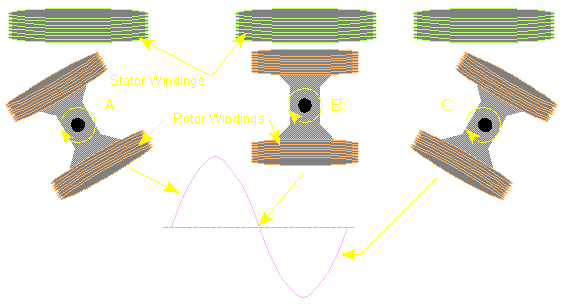
Rectification: You should have noticed that the generated voltage was AC. You already know that a vehicle's charging system needs to produce DC to recharge the battery. This is done with diodes. The following diagram shows a simple transformer and a bridge rectifier. The transformer is driven with a sine wave (similar to that produced in each stator coil). Since the transformer is driven with a sine wave, the output of the transformer is a sine wave (similar to the one shown). The sine wave is driven into the bridge rectifier and the output is a pulsed DC waveform.
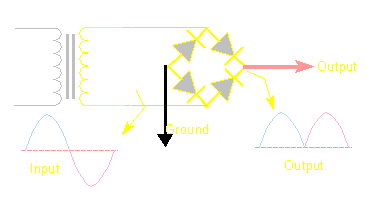
Bridge rectifier: You should also realize that there are 3 different groups of stator coils in an alternator (not shown in diagrams). The rectification is much like the simple transformer shown above but in the place of a single transformer winding there are 3 windings. It also uses 6 diodes instead of 4.
3 Phase: The following diagram shows the 3 different phases from the 3 groups of stator windings. The three phases of AC are shown in three different colors. The next set of lines shows the rectified waveforms overlapped. The bottom waveform (white line) is what the rectified voltage would actually look like if viewed on an oscilloscope. Connecting the battery to the alternator will smooth the white line even more.
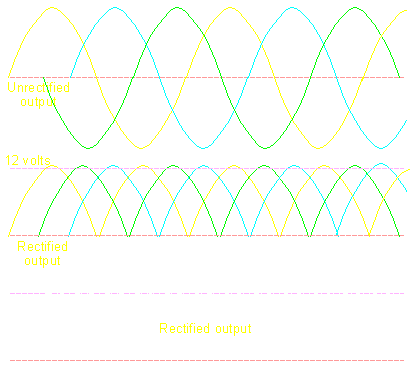
Alternator Schematic: The following is a generic schematic showing the stator windings and the bridge rectifier. You also see a diode trio. the diode trio takes part of the output and sends it to the voltage regulator. The output diodes are the rectifiers that rectify the AC and supply power to your electrical accessories.
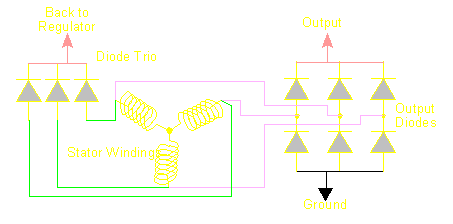
Brushes and Slip Rings: For an alternator to produce electrical current, there needs to be some excitation current flowing in the rotor windings. Since the rotor is spinning, you can't just connect a couple of wires to it (cause they'd just be twisted off  . To make the electrical connection, slip rings and brushes are used. The slip rings are fixed to the shaft of the rotor. The brushes are fixed to the stationary part of the alternator. The brushes, which are generally made of carbon, are spring loaded to keep constant pressure on the slip rings as the brushes wear down. The following diagram shows the general location of the rotor and the associated parts. . To make the electrical connection, slip rings and brushes are used. The slip rings are fixed to the shaft of the rotor. The brushes are fixed to the stationary part of the alternator. The brushes, which are generally made of carbon, are spring loaded to keep constant pressure on the slip rings as the brushes wear down. The following diagram shows the general location of the rotor and the associated parts.
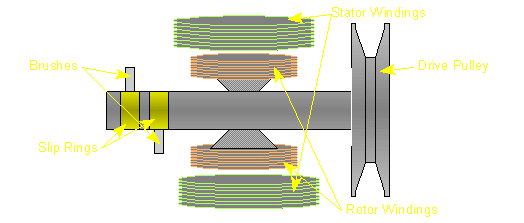
Voltage Reguation: As you already know from the 'wire' page, all wire has resistance. You also know that when you have current flow through a resistive element (wire), there will be a voltage loss. If the current draw from the charging system was constant, there would be no need for a voltage regulator. If there was no loss, the design engineer would simply design the alternator to produce a given voltage. This won't work with a car audio system because the current draw is anything but constant. This means that the alternator needs a compensating voltage regulator. The voltage regulator controls the flow of current in the rotor's windings. The voltage regulator's output current will typically be between 0 amps (with little or no current draw) and 5 amps (at maximum current draw). The regulator can vary the current flow infinitely to keep the voltage precisely at the target voltage. Generally the regulator is built into the alternator. There are some high current/special use alternators which may have external regulators. Some of the external regulators are adjustable via a potentiometer.
Current demand and flow: If you have an alternator that can produce 120 amps of current (max) and the the total current demand from the electrical accessories (including the battery) is only 20 amps, the alternator will only produce the necessary current (20 amps) to maintain the target voltage (which is determined by the alternator's internal voltage regulator). Remember that the alternator monitors the electrical system's voltage. If the voltage starts to fall below the target voltage (approximately 13.8 volts depending on the alternator's design), the alternator produces more current to keep the voltage up. When the demand for current is low, the full current capacity of the alternator is not used/produced (a 120 amp alternator does not continuously produce 120 amps unless there is a sufficient current draw).
Dimming lights: When you play your system at very high volumes and the lights on your vehicle dim slightly, it generally means that your alternator can not supply enough current for all of your electrical accessories (including your amplifiers). If you play a long bass note/tone and the lights get dim and stay dim until the note is over, your alternator clearly can not keep up with the current demand. If, on a long bass note, the lights dim just for a fraction of a second but return to their original brightness while the note/tone is still playing, the alternator's regulator may just be a little slow in reacting to the voltage drop. Since the lights return to their original brightness during the bass note, the alternator is able to supply the current needed by your power your amplifiers and other electrical accessories.
Warning!
Some people tell you that you can check your alternator by disconnecting it from the battery to see if the alternator can produce enough current to keep the engine running. BAD IDEA! Disconnecting the battery will subject the voltage regulator (and computer and audio equipment...) to significant voltage spikes which may cause an otherwise good alternator to fail. Even if there were no damaging spikes, this test would not indicate whether or not the alternator was good because the engine will easily run with a weak or failing alternator.
Simple Test: If you want to see if your alternator is producing current, turn on your headlights when you're parked and the engine idling with the headlights shining on a wall (at night). Notice how bright they are. Then turn the engine off. The lights should get dimmer when you turn the engine off. If the lights get brighter when you kill the engine, the alternator was not charging sufficiently. When doing this test, the lights should be the only load (turn the stereo, a/c and other accessories off). With a heavy load, an otherwise good alternator may not be able to produce sufficient amounts of current at idle.
Basic Battery Information
Battery Construction: A standard 12 volt cranking battery has 6 individual cells. Each cell is designed to produce ~2.1 volts. The cells are connected in series for a total of about 12.5 volts. Each cell basically consists of 1 set of lead plates and 1 set of lead plates coated with lead dioxide submerged in a sulfuric acid electrolytic solution.
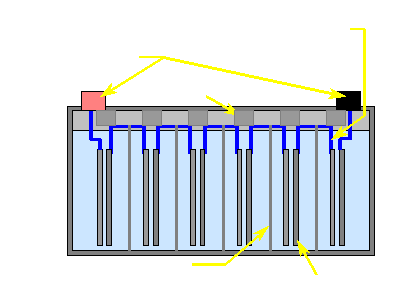
Electrolyte Levels: The level of the electrolyte should be about 1/8" below the bottom of the filling wells. If the electrolyte is above the bottom of the well, it may be forced out when the battery is charged. If the electrolyte is allowed to fall to below the top of the plates, the battery will be damaged. If the level of the electrolyte is low, refill it with distilled water only. Regular tap water has minerals which may coat the plates and reduce the battery's capacity.
Distilled Water: Distilled water is water that's been heated to cause it to evaporate into water vapor. The water vapor is then condensed back into liquid water. The distilled water is free of all impurities including minerals that would coat the plates of the battery and therefore reduce its capacity to produce electrical current.
Cranking Amps: Cranking amps is the spec that tells you how much current a battery can produce for 30 seconds at a temperature of 32° F and not have the voltage on any of the individual cells drop below 1.2 volts (7.2 volts for a 6 cell automotive battery). This may also be known as MCA or marine cranking amps.
Cold Cranking Amps: This is the same test as cranking amps but is done at 0° F. The CCA spec is especially important if you live in a really cold climate. Since the chemical reaction that produces electrical current in the battery slows down as the temperature drops, the battery can produce less current at colder temperatures (especially below freezing). When comparing the current capacity of batteries, make sure that you have some standards to qualify the current ratings. If you see the current rating without CA or CCA, you don't know how the battery was tested and the current rating is virtually useless.
Reserve Capacity: The reserve capacity is the time that a battery can produce 25 amps at 80° F before the individual cell voltage drops below 1.75 volts (10.5 volts for a 6 cell automotive battery).
Deep Cycle vs Standard Battery: - A normal lead-acid battery will be damaged if it is completely drained (even if it's only one time).
- A deep cycle battery is designed to survive being drained multiple times.
- Deep cycle batteries have more reserve capacity but have less cranking amps for a given size.
- A standard battery would have more total surface area on its plates when compared to a deep cycle battery of equal size. This extra surface area provides more area for the chemical reaction to take place and therefore produce a higher output current.
- The electrolyte in a deep cycle will be a slightly more concentrated sulfuric acid than a standard battery.
Gel-cell Batteries: Gel-cell batteries use a thickened (gelled) electrolyte that will not leak out like a liquid electrolyte. Many of them can be mounted in virtually any position. These batteries may be suitable for some applications but for engine starting, other batteries should be used. Gel-cell batteries can not produce as much current for long periods of time as standard liquid electrolye batteries.
Recombinant Gas Batteries: RG batteries have only 2 long thin plates per cell. They are constructed much like an electrolytic capacitor. The plates are separated by a fiberglass mat material designed to hold the electrolyte. These long thin plates have significant amounts of surface area (compared to standard batteries). This extra surface area allows the battery to produce significantly more current than standard batteries of similar physical size. Optima® is one manufacturer of RG batteries. If you're going to add batteries to your system and the batteries will be in the vehicle's trunk or passenger compartment, RG batteries won't vent flammable hydrogen gas or corrosive gasses into the vehicle.
Group Size: The battery group size is an indicator of the battery's physical dimensions.
---------------------------------------------------------------------
TROUBLESHOOTING BASIC STARTING SYSTEM PROBLEMS
Many starting system problems are the result of neglect. This chart will show you which problems you can fix yourself and which require professional service. Problem Is Caused By What To Do Engine does not crank (Solenoid or relay does not click) Dead battery Charge or replace battery Loose, corroded or broken connections Clean or repair connections Corroded battery terminals (lights will usually light) Clean terminals Faulty ignition switch Have ignition switch checked/ replaced Faulty neutral safety switch or clutch switch (To test: push on brake pedal, hold key in start position and move shift lever or clutch pedal) Have neutral safety switch or clutch switch checked or replaced Defective starter switch, relay or solenoid. Have defective component replaced Engine will not crank (Solenoid or relay clicks) Low or "dead" battery Charge or replace battery Corroded battery terminals or cables Clean or replace terminals or cables Defective starter solenoid or relay Have defective component replaced Defective starter motor (if current is passed through relay or solenoid) Have starter replaced or overhauled Starter motor cranks slowly Low battery Charge or replace battery Loose, corroded or broken connections Clean, repair or replace connections Cable size too small Replace with proper size cable Internal starter motor problems Have starter replaced or overhauled Engine oil too heavy Use proper oil viscosity for temperature Ignition timing too far advanced Set timing to specifications Starter spins, but will not crank engine Broken starter drive gear Have drive gear replaced Broken flywheel teeth Have flywheel checked Noisy starter motor Starter mounting loose Tighten mounting bolts Worn starter drive gear or flywheel teeth Have starter or flywheel checked Worn starter bushings Have starter replaced or overhauled
link works better... http://www.procarcare.com/includes/c...sstartPBs.html
-------------------------------------------------------------------
TROUBLESHOOTING BASIC CHARGING SYSTEM PROBLEMS
There are many charging system problems you can fix yourself. This chart will show you which ones you can fix and which ones require professional service. Problem Is Caused By What To Do Noisy Alternator Loose mountings Tighten mounting bolts Loose drive pulley Tighten pulley Worn bearings Have bearings replaced Brush noise Have brushes cleaned /replaced Internal circuits shorted (High pitched whine) Have alternator replaced or overhauled Squeal when starting engine or accelerating Glazed or loose belt Replace or adjust belt Indicator light remains on or ammeter indicates discharge (engine running) Broken fan belt Install belt Broken or disconnected wires Repair or connect wiring Internal alternator problems Have alternator overhauled /replaced Defective voltage regulator Have voltage regulator replaced Car light bulbs continually burn out-battery needs water continually Alternator/ regulator overcharging Have voltage regulator/alternator overhauled or replaced Car lights flare on acceleration Battery low Charge or replace battery Internal alternator/ regulator problems Have alternator/ regulator overhauled or replaced Low voltage output (alternator light flickers continually or ammeter needle wanders) Loose or worn belt Replace or adjust belt Dirty or corroded connections Clean or replace connections Internal alternator/ regulator problems Have alternator or regulator overhauled or replaced
and heres this link... http://www.procarcare.com/includes/c...chargePBs.html
Last edited by V; 03-20-2011 at 07:48 PM.
|

|

|
 Posting Rules
Posting Rules
|
You may not post new threads
You may not post replies
You may not post attachments
You may not edit your posts
HTML code is Off
|
|
|
|
|
|

